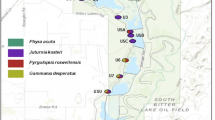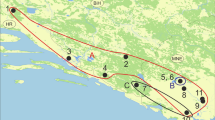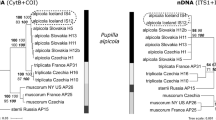Summary
Ecological and genetic properties of two North American terrestrial gastropods (Mesomphix spp.) were characterized in paired control and previously logged watersheds in two North Carolina forests (Coweeta and the Great Smoky Mountains National Park) of the Southern Appalachian Biosphere Reserve Cluster. Shell growth was greater in the control sites, but density and mortality were largely independent of prior logging history and forest reserve. Based on starch gel electrophoresis data, both species showed their highest levels of genetic diversity in the Coweeta forest, the component of the reserve cluster which had the most extensive and variable history of logging disturbance. M. subplanus also exhibited higher levels of heterozygosity in logged than in control watersheds, and M. andrewsae showed over twice as many rare alleles in disturbed sites as in control sites. F-statistic analysis depicted both excess levels of homozygosity and moderate genetic differentiation among the populations, reflecting the effects of small population size and perhaps drift and inbreeding. Estimated gene flow was relatively low. These results correspond to the recent finding by Bryant et al. (1987) and others on the effects of bottlenecks, and to the contrasting history of habitat instability of the two major study forests.
Similar content being viewed by others
References
Abbott DT, Seastedt TR, Crossley DA (1980) The abundance, distribution and effects of clear-cutting on Cryptostigmata in the southern Appalachians. Environ Entomol 9:618–623
Ash AN (1983) Population responses of Plethodon jordani and P. glutionosus to logging and regeneration. III. The fourth year after logging. Unpubl. Report. Highlands Biological Station. Highlands, NC, USA
Allendorf FW, Leary RF (1986) Heterozygosity and fitness in natural populations of animals. In: Conservation Biology Soulé M (ed). Sinauer, Suderland, MA, pp 57–76
Brussard PF, McCracken GF (1974) Allozyme variation in a North American colony of Cepaea nemoralis. Heredity 33:98–101
Bryant EH, McCommas SA, Combs LC (1986a) The effect of an experimental bottleneck upon quantitative genetic variation in the housefly. Genetics 114:1191–1211
Bryant EH, Combs LA, McCommas SA (1986b) Morphometric differentation among experimental lines of the housefly in relation to a bottleneck. Genetics 114:1213–1223
Burch JB (1962) How to know the eastern land snails. W.C. Brown. Dubuque, Iowa. p 214
Cain AJ (1983) Ecology and ecogenetics of terrestrial molluscan populations. In: Russel-Hunter WD (ed) The Mollusca. Vol 6 (Ecology). Academic Press, NY, pp 597–647
Cameron RA, Dillon PJ (1984) Habitat stability, population histories and patterns of variation in Cepaea. Malacologia 25:271–290
Carson HL, Templeton AR (1984) Genetic revolutions in relation to speciation phenomena: the founding of new populations. Annu Rev Ecol Syst 15:97–131
Carter MA, Ashdown M (1984) Experimental studies on the effects of density, size, and shell color and banding phenotypes on the fecundity of Cepaea nemoralis. Malacologia 25:291–302
Clark BC (1978) Some contributions of snails to the development of ecological genetics. In: Brussard PF (ed) Ecological Genetics: The Interface. Springer Berlin Heidelberg New York, pp 159–170
Clark BC, Arthur W, Horsley DT, Patkin, DT (1978) Genetic variation and natural selection in pulmonate molluscs. In: Fetler V, Peake J (eds) The Pulmonates Vol. 2A Academic Press. New York, NY, pp 219–270
Cowie RH (1984) Shell thickness in the land snail Theba pisana (Pulmonata, Helicidae). Biol J Linn Soc 21:423–430
Dan N, Bailey SER (1982) Growth, mortality, and feeding rates of the snail Helix aspersa at different population densities in the laboratory, and the depression of activity helicid snails by other individuals, or their mucus. J Mollus Stud 48:257–265
Dillon RT, Davis GM (1980) The Goniobasis of southern Virginia and northwestern North Carolina: genetic and shell morphometric relationships. Malacologia 20:83–90
Dils RE, (1957) A guide to the Coweeta Hydrologic Laboratory. USDA (Forest Service). S.E. Experiment Station, Asheville, NC USA
Douglass JE, Swank WT (1976) Multiple use in Southern Appalachian hardwoods — a 10-year case history. XVI IUFRO World Congress Div. 1, Proc 1976, 425–436 (Distrib by IUFRO Secretariate, Schonbrunn-Tirolergarten A-1131 Vienna)
Emberton KC (1988) The genitalic, allozymic, and conchological evolution of the eastern North American Triodopsinae (Gastropoda: Pulmonata: Polygyridae). Malacologia 28:159–273
Frankel OH, Soulé ME (1981) Conservation and evolution. Cambridge Univ Press, London
Goodfriend GA (1986) Variation in land-snail shell form and size and its causes: a review. System Zool 35:204–223
Goodhart CB (1963) Area effects and non-adaptive variation between populations of Cepaea (Mollusca). Heredity 18:459–471
Goodnight CJ (1987) On the effect of founder events on epistatic genetic variance. Evolution 41:80–91
Goodnight CJ (1988) Epistasis and the effect of founder events on the additive genetic variance. Evolution 42:441–454
Harris H, Hopkinson DA (1978) Handbook of enzyme electrophoresis in human genetics. North Holland Pub Co, NY
Hartl DL (1980) Principles of population genetics, Sinauer, Sunderland, MA p 499
Hubricht L (1984) The distribution of the native land mollusks of the eastern United States. Fieldiana, New Series, No 24
Johnson PL, Swank WT (1973) Studies on cation budgets in the Southern Appalachians on four experimental watersheds with contrasting vegetation. Ecology 54:70–80
Jones JS, Lieth BH, Rawlings P (1977) Polymorphism in Cepaea: a problem with too many solutions. Annu Rev Ecol Syst 8:109–143
Koehn RK, Mitton JB (1972) Population genetics of marine pelecypods. I. Ecological heterogeneity and evolutionary strategy at an enzyme locus. Am Nat 106:47–56
Lande R (1980) Genetic, variation and phenotypic evolution during allopatric speciation. Am Nat 116:463–479
Lande R, Barrowclough GF (1987) Effective population size, genetic variation, and their use in population management. In: Soulé M (ed) Viable Populations for conservation. Cambridge Univ Press, London pp 87–123
Larson A, Wake DB, Yanev KP (1984) Measuring gene flow among populations having high levels of genetic fragmentation. Genetics 106:293–303
Lenski RE (1982) Effects of forest cutting on two Carabus species: evidence for competition for food. Ecology 63:1211–1217
Lerner IM (1954) Genetic homeostasis, Oliver and Boyd. London
Levan G, Fredga K (1972) Isoenzyme polymorphism in three species of land snails. Hereditas 71:245–252
Levene H (1949) On a matching problem arising in genetics. Annal Math Stat 20:91–94
Lewontin RC (1965) Comments. In: Baker HG, Stebbins GL (eds) The Genetics of Colonizing Species. Academic Press, New York, NY pp 481–484
Lewontin RC (1966) On the measurement of relative variability. System Zool 15:141–142
Lewontin RC (1974) The genetic basis of evolutionary change. Columbia Univ Press, New York, NY
Mayr E (1954) Change of genetic environment and evolution. In: Huxley J, Hardy A, Ford EB (eds) Evolution as a Process. Allen and Unwin, London
Maruyama T, Fuerst PA (1985) Population bottlenecks and nonequilibrium models in population genetics. II. Number of alleles in a small population that was formed by a recent bottleneck. Genetics 111:675–689
McCracken GF, Brussard PF (1980) The population biology of the white-lipped land snail, Triodopsis albolabris genetic variability. Evolution 34:92–104
Mitton JB, Grant MC (1984) Associations among protein heterozygosity, growth rate, and developmental homeostasis. Annu Rev Ecol Syst 15:479–499
Mulvey M, Vrjenhoek RC (1981) Genetic variation among laboratory strains of the planorbid snail Biomphaloria glabrata. Biochem Genet 19:1169–1182
Nei M (1977) F-statistis and analysis of gene diversity in subdivided populations. Annal Human Genet 41:225–233
Nei M (1978) Estimation of average heterozygosity and genetic distance from a small number of individuals. Genetics 89:583–590
Nei M (1986) Definition and estimation of fixation indices. Evolution 40:643–645
Nei M, Maruyama T, Chakroborty R (1975) The bottleneck effect and genetic variability in populations. Evolution 29:1–10
Oosterhoff LM (1977) Variation in growth rate as an ecological factor in the landsnail Cepaea nemoralis (L.). Neth J Zool 27:1–132
Pickett ST, White PS (Eds) (1985) The ecology of natural disturbance and patch dynamics. Academic Press. New York, NY, p 472
Pilsbry HA (1946) Land mollusca of North America. Academy of Natural Sciences of Philadelphia, Monographs No. 3. Vol II, Part 1, p 520
Rice K, Jains S (1985) Plant population genetics and evolution in disturbed environments. In: Pickett S, White P (eds) The Ecology of Natural Disturbance and Patch Dynamics Academic Press, New York, NY, pp 287–303
Riddle WA (1983) Physiological ecology of land snails and slugs. In: The Mollusca. Vol 6 (Ed Russell-Hunter WD). Academic Press, New York, NY, pp 431–461
Seastedt TR, Crossley DA (1981) Microarthropod response following cable logging and clear-cutting in the southern Appalachians. Ecology 62:126–135G
Selander RK, Kaufman DW (1973) Self fertilization and population structure in a colonizing land snail. Proc Nat Acad Sci (USA) 70:1186–1190
Selander RK, Kaufman DW (1975) Genetic structure of populations of the brown snail (Helix aspersa). I. Microgeographic variation. Evolution 29:385–401
Selander RK, Ochman H (1983) The genetic structure of populations as illustrated by molluscs. Isozymes: Current Topics in Biol Med Res 10:93–123
Selander RK, Whittam TS (1983) Protein polymorphism and the genetic structure of populations. In: Evolution of Genes and Proteins (Ed Nei M, Koehn RK), Sinauer, Suderland, MA, pp 89–114
Selander RK, Smith MH, Yang Y, Johnson WE, Gentry JB (1971) Biochemical polymorphism and systematics in the genus Peromyscus. I. Variation in the field mouse (Peromyscus polionotus). Stud Genet VI, Univ Texas Publ 7103:49–90
Slatkin M (1985) Gene, flow in natural populations. Annu Rev Ecol Syst 16:393–430
Sousa WP (1984) The role of disturbance in natural communities. Annu Rev Ecol Syst 15:353–392
Stiven AE, Bruce RC (1988) Ecological genetics of the salamander Desmognathus quaddramaculatus from disturbed watersheds in the southern Appalachian Biosphere Reserve Cluster. Cons Biol 2:194–205
Swank WT, Crossley DA (eds) (1988) Forest hydrology and ecology at Coweeta. Ecol Stud 66. Springer, Berlin Heidelberg New York
Swank WT, Douglass JE (1975) Nutrient flux in undisturbed and manipulated forest ecosystem in the Southern Appalachian mountains. Proc Toyoko Sym Hydrol Charact River Basins 1975:445–456
Swofford DL, Selander RB (1981) Biosys-1: a Fortran program for the comprehensive analysis of electrophoretic data in population genetics and systematics. J Hered 72:281–283
Vrijenhoek RC (1985) Animal population genetics and disturbance: the effects of local extinctions and recolonizations on heterozygosity and fitness. In: Pickett S, White P (eds) The Ecology of Natural Disturbance and Patch Dynamics Academic Press, New York, NY, pp 265–285
Waples RS (1987) A multispecies approach to the analysis of gene flow in marine fishes. Evolution 41:385–400
Workman PL, Niswander JD (1970) Population studies on southwestern Indian tribes. II. Local genetic differentation in the Papago. Am J Hum Genet 22:24–49
Wright S (1931) Evolution in Mendelian populations. Genetics 16:97–159
Wright S (1978) Evolution and the genetics of populations. Vol. 4. Variability within and among natural populations. Univ Chicago Press. Chicago, Illinois
Zink RM, Smith MF, Patton JL (1985) Association between heterozygosity and morphological variance. J Hered 76:415–420
Author information
Authors and Affiliations
Rights and permissions
About this article
Cite this article
Stiven, A.E. Population biology of two land snails (Mesomphix spp.): variation among six southern appalachian sites with differing disturbance histories. Oecologia 79, 372–382 (1989). https://doi.org/10.1007/BF00384317
Received:
Published:
Issue Date:
DOI: https://doi.org/10.1007/BF00384317




